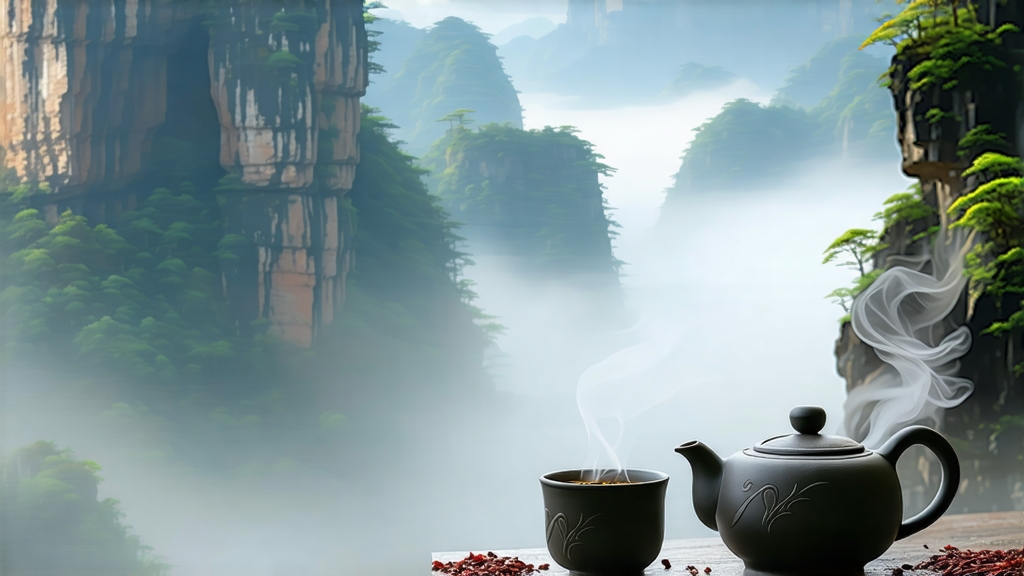
Ask any Chinese tea lover to name one tea that tastes of stone, orchid, and legend at once, and the answer is almost always Da Hong Pao—Big Red Robe—the flagship of Wuyi rock oolong. Born in the vertiginous gorges of northern Fujian, this tea carries the terroir of a UNESCO World Heritage site where mineral-rich cliffs, running springs, and morning mists conspire to create the elusive “rock rhyme” (yanyun) that connoisseurs prize above all else. Yet Da Hong Pao is more than a beverage; it is a living palimpsest of Song-dynasty imperial tribute, Ming-era monks, Qing-era merchants, Republican-era smugglers, and 21st-century auction headlines. To drink it is to sip five centuries of Chinese history in a single cup.
The origin myth is cinematic. In 1385, a Ming scholar on his way to the capital fell violently ill at the foot of the Wuyi’s Nine-Dragon Gorge. Monks from the nearby Tianxin Temple brewed leaves plucked from six ancient bushes clinging to the cliff; the scholar was cured, passed the imperial exam top of his class, and returned in vermillion robes to thank the trees by draping his own robe over them. The name Big Red Robe stuck, and the six mother trees—still visible today on a precipice above the Jiuqu Stream—became the most guarded plants in China. In 2006 the government ceased all plucking from them, declaring the 350-year-old trees a living cultural relic; every gram of “mother-tree” tea ever sold is now either locked in museum vaults or counterfeited.
Fortunately, the variety is not a single tree but a collective cultivar. Cuttings taken from the original bushes in the 1960s created the so-called “pure” Da Hong Pao (qizhong), while skilled blenders also marry selected Wuyi cultivars—Rougui for cinnamon spark, Shui Xian for honeyed body, Tie Luo Han for iron-mineral depth—to recreate the mother-tree profile in “commodity” Da Hong Pao. The result is a spectrum: from museum-grade heritage batches auctioned for tens of thousands of dollars per gram to everyday “rock tea” that delivers yanyun without bankruptcy.
Making Da Hong Pao is a sixteen-step choreography that stretches across two seasons and three moons. The first act begins in late April when the mist is thickest. Pickers climb bamboo scaffolding to harvest the standard “open leaf” of one bud and three or four leaves—older leaves than those used for green tea, because oxidation will soften their toughness. The pluck must finish before 10 a.m.; dewy leaves oxidize unevenly, while afternoon sun scorches the edges. Once down the cliff, the leaves are spread on bamboo trays and withered under the mountain breeze and the indirect heat of charcoal embers. This “two-stage wither” lasts eight to ten hours, driving away grassy volatiles while concentrating precursor sugars.
Next comes yaoqing—the “rocking green.” The withered leaves are tossed in a rattan drum rotating at 18 rpm, bruising the edges just enough to liberate enzymes without heating the leaf core. The rhythm is hypnotic: five minutes tumbling, twenty minutes resting, repeated six times through the night. By dawn the leaf margins have turned russet while the veins remain jade, the signature “green leaf with red border” of rock oolong. Oxidation is arrested at roughly 40 %—halfway between green and black—by a 220 °C tumble in an electric wok for three minutes, a step locals call “killing the green,” though what dies is the enzymatic browning, not the leaf’s soul.
What follows is Wuyi’s unique “double firing.” The leaves are first baked over a gentle 80 °C charcoal bed for two hours, then left to breathe for a week, allowing residual moisture to migrate outward. A second firing at 120 °C follows, this time in small bamboo baskets nestled in ash-covered embers. The charcoal is not any wood but the aromatic trunks of local Masson pine that has aged three years; its resinous smoke imparts a whisper of camphor and smoked plum that later emerges in the cup as the coveted “rock fragrance.” After the bake, the tea rests again—anywhere from one month to